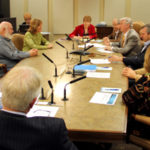In the News: Nutrition Conference, New York City

Bringing home healthful food has gotten more difficult over the last few decades, and our system of food production and marketing is to blame – that was the message from Dr. Weil and other food and health experts at the Public Forum on Food, Politics and Society held at the Marriott Marquis Hotel in New York City on April 30. The public forum kicked off the third annual Nutrition and Health Conference: State of the Science and Clinical Applications, an educational meeting for healthcare professionals, which started the next day.
Moderated by New York National Public Radio host Leonard Lopate, the panel featured Andrew Weil, M.D.; Dan Barber, the executive chef of Blue Hill and creative director of the Stone Barn center for food and agriculture; Joan Gussow, Ed.D., former chair and professor emeritus of nutrition and education at Columbia University; and Marion Nestle, M.P.H., Ph.D, professor in the department of nutrition, food studies and public health at New York University and author of “Food Politics” and “What to Eat.” The four speakers explained how government policies combine with market pressures to create supermarkets that are “hazard zones” full of foods that contribute to obesity and chronic diseases such as diabetes. The only way to ensure that fresh, healthful food will continue to be available – and affordable – is to work to change food policy, production, and delivery.
“You vote with your fork, not just for the food you want on your plate tonight, but the world you want to live in tomorrow,” said Nestle. “We urge you to become more informed,” said Dr. Weil.
What should consumers know about? What can you do? Weil and the others were quite specific:
- Demand healthful choices. Dr. Weil used fish as an example. While fish such as salmon and trout contains healthful omega-3 fats, farmed fish is less than ideal to eat because it’s raised on contaminated feed. “Farmed fish is the future, and you have it within your power to change the way fish is raised,” said Dr. Weil. “Demand clean feed and better management of fish farms for a cleaner, more healthful product.” Consumers can lobby for tougher standards; panelists recommended learning more about the 2007 Farm Bill, which sets many food policies.
- Buy locally produced foods. “What we eat has more impact on climate change than any other thing,” said Gussow. Fruits, vegetables and packaged edibles are produced far from where they’re consumed; food corporations rely on cheap, plentiful oil for transport. “Our present petroleum-based food system is unsustainable,” Gussow said. Supporting local farms ensures personal food security—when energy prices escalate or there is a global crisis, locally produced food will be available, and be the less expensive option. Already it is kinder to the environment. “A good food is one that is produced close to where it consumed, without harm to the ecosystem, and is seasonal or capable of storage without using lots of energy,” Gussow said.
- Consider more than cost. When stores and food producers – even those that market organic products – grow large and become publicly traded, they come under pressure to cut costs. Smaller farmers suffer if they can’t lower their costs and maintain high quality. “All along the food chain, price is everything,” said Barber. “But if we can get people to consider things other than price, such as flavor, that’s better for everyone.” Farmers’ markets and community-supported agriculture (CSA) are ideal small-scale, local food sources, the panelists agreed.
- Look to the source of recommendations. “Everything about food is political,” said Nestle. Lobbyists influence government recommendations about the kind and amount of food you should eat – even its health effects. “Many of the government’s so-called scientific experts have come directly from the food industry,” said Dr. Weil. The dairy industry lobbied for recommendations to include three, not two, servings a day, even though there is not a strong link between dairy and health – even dairy and bone strength, he said. The U.S. Department of Agriculture’s 1995 food pyramid listed foods at each level; the 2005 food pyramid does not. “There’s no food on the pyramid now,” says Nestle. “No one wants to be at the top with junk food.”
- Curb your consumption. With the market for food growing only one percent a year in the U.S., corporations battle to sell every mouthful. And there’s more food to push: 700 more calories per capita is being produced than in 1984. The pressure to buy and eat can be overwhelming. Even the government’s food guidelines are fatter – and more confusing. “The food guidelines used to be seven simple sentences,” said Nestle. “Now there are 47 recommendations.” For example, the guideline that used to read, “Eat less sugar,” is now 48 words long. “’Eat less’ is not good for business,” said Nestle.
- Seek advice from informed sources. Even though there is general agreement among researchers and nutritionists about a healthy diet, most doctors are not informed about food and health, said Dr. Weil. It also seems as if the media reports a new nutrition study each week that refutes the last week’s report. Labels on foods add to the confusion, presenting low-fiber, high-sugar cereals as “heart healthy” for example, when they are anything but. Despite these mixed messages, “there is a consensus; we do know what’s healthful,” said Weil.
- Find a doctor who’s informed about nutrition: Go to the Arizona Center for Integrative Medicine and find graduates of the program.
- Lobby yourself: The 2007 Farm Bill will set policy for subsidies, school lunches, and more. Think of it as the Food Bill. Find out more at www.sustainableagriculture.net/
By Kathy Kukula
DrWeil.com News









